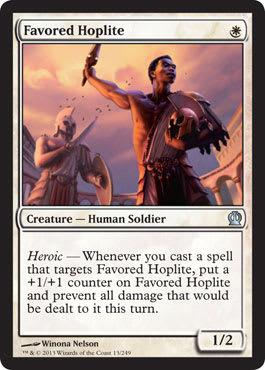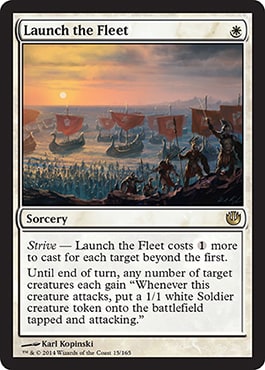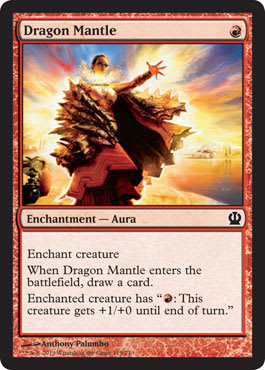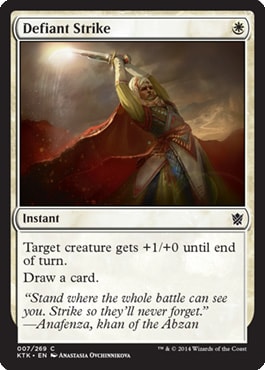So far, it seems that the new Standard format will be dominated by aggressive Jeskai decks and Abzan midrange, at least for the time being. Although midrange has a long history of stomping on aggro decks, Jeskai circumvents the large blockers by playing creatures with flying and plenty of direct damage. This led me to thinking about another way aggro decks can beat midrange: having bigger creatures.
To be fair, it’s not something that happens often, but decks that make one creature into a gigantic threat generally do a good job of beating midrange decks, and they can often outrace traditional aggro as well. Control decks are often a problem, but those seem to be few and far between right now. Those that do exist often rely largely on one-for-one removal spells, a weakness we can exploit. Here’s the deck I built to try to take advantage of the current format without requiring a pile of cash.
Boros Heroes ? Khans of Tarkir Standard | Mike Cannon
- Creatures (20)
- 2 Hero of Iroas
- 3 Akroan Crusader
- 3 Eidolon of Countless Battles
- 4 Favored Hoplite
- 4 Phalanx Leader
- 4 Satyr Hoplite
- Spells (20)
- 4 Defiant Strike
- 4 Gods Willing
- 4 Launch the Fleet
- 4 Dragon Mantle
- 4 Hammerhand
- Lands (20)
- 4 Mountain
- 7 Plains
- 2 Temple of Triumph
- 3 Wind-Scarred Crag
- 4 Battlefield Forge
The Heroes
Favored Hoplite and Satyr Hoplite can kick the deck off to a very quick start, often attacking for 3 or 4 damage on the second turn. Now, I don’t like to play favorites, but one of these is clearly better. That said, having four copies of each makes it much more likely you’ll have one in your opening hand.
Hero of Iroas is mostly just a bigger Satyr Hoplite, but it does come with a marginal advantage, letting you bestow Eidolon of Countless Battles for 3 mana instead of 4. For a deck as light on lands as this one, that can be a big help.
Akroan Crusader is a bit different than the other heroic guys here, making 1/1 tokens instead of putting +1/+1 counters on itself. This gives you the option of going wide against decks with loads of removal. Those tokens can also add a surprising amount of damage to the board with the help of some other cards in the deck.
One of those cards is Phalanx Leader. Although it’s a bit tougher to cast than other creatures and doesn’t have much power at first, the ability to add counters to all your creatures instead of just one can easily swing games in your favor. When the tokens from cards like Akroan Crusader and Launch the Fleet turn into 3/3s, your opponent’s Hero's Downfall won’t seem nearly as effective.
The Tools
Launch the Fleet pulls double-duty in this deck. Not only is it among the best heroic enablers around, it can do some pretty sick damage as well. With three heroes on the battlefield, this card can give them all +1/+1 counters for 3 mana. Then, when those creatures attack, you’ll make another three creatures to go with them. That’s a potential 6 damage for just a small 3-mana investment, and that’s far from the best this card can do.
Eidolon of Countless Battles really makes all these tokens count. Bestowing it onto an Akroan Crusader will take you from 1 power on the battlefield to 5, and that’s with no other creatures or Auras to help out. Bring some friends along, and the Eidolon can make for a nasty surprise that won’t be dealt with easily.
Hammerhand does a lot of work in this deck. For 1 mana, it triggers heroic, gives the creature a permanent +1/+1, and takes a blocker out of commission for the turn. It’s also another Aura for the Eidolon to count. Oh yeah, it gives haste, too, just in case you have a creature in hand that wants to join the battle right away.
Dragon Mantle and Defiant Strike trigger heroic for just 1 mana while replacing themselves with new cards. That helps you keep triggering heroic abilities throughout the game rather than just relying on a few early triggers to get the job done. The primary weakness of heroic decks has always been the card advantage that a removal spell can provide for your opponent. Take that away, and the road to victory becomes that much easier.
Speaking of removal spells, Gods Willing does a great job of countering those while still triggering heroic. It can also be used to sneak a giant creature past your opponent’s blockers, often for enough damage to end the game. Most decks have many creatures that share a color, thanks to the three-colored cards from Khans of Tarkir. Naming green will push an attacker through Sylvan Caryatid, Courser of Kruphix, Polukranos, World Eater, and even Siege Rhino. If there is an off-color creature on the battlefield, Hammerhand can often be used to take it out of the equation.
Playtesting
Jeskai Wins — Game 1
I won the roll and started things off with Satyr Hoplite. My opponent passed the turn after playing a Temple, and I played a Temple of my own.
I cast Dragon Mantle on the Hoplite and got in for 2 damage. My opponent played another Temple before ending his turn.
I cast another Satyr Hoplite and put Hammerhand on it. I attacked for 5 and passed the turn. My opponent paid 1 life to use Flooded Strand, and he cast Mantis Rider. He attacked for 3 damage in the air.
I cast a second Dragon Mantle on the smaller Hoplite, bringing it up to 3/3. Launch the Fleet targeting both made them too big for Mantis Rider to take down, and I attacked, putting two attacking Soldiers on the battlefield. My opponent blocked a Soldier with the Rider, dropping to 3.
My opponent passed the turn with no play, and I cast another Launch the Fleet, targeting the two Hoplites. My opponent cast Jeskai Charm in response, but I was ready with Gods Willing to counter it and make the creature unable to be blocked by Mantis Rider. I attacked with everything for more than enough damage to win the game.
Game 2
My opponent started off with Mystic Monastery, and I cast Favored Hoplite.
He played Battlefield Forge and passed the turn, and I cast Hammerhand on the Hoplite. My opponent tried to kill it with Magma Jet in response, but I cast Defiant Strike to trigger the heroic ability and prevent the damage. I attacked for 5 (On turn two!) and ended my turn.
My opponent played another Monastery and passed the turn. I attacked for 4 and cast a second Favored Hoplite. I played a Temple of Triumph and ended my turn.
My opponent cast Jeskai Charm to put the large Hoplite on top of my library. I bestowed Eidolon of Countless Battles onto the remaining Hoplite and attacked for 4, dropping my opponent to 7.
My opponent hit this Hoplite with Jeskai Charm as well and passed the turn. I cast both Hoplites and targeted all three creatures with Launch the Fleet. (I knew there was another copy on top due to the scry from my Temple.) The Eidolon attacked, putting a Soldier on the battlefield. My opponent dropped to 2 life, and I passed the turn.
My opponent played a land and passed back. I cast Launch the Fleet targeting all my creatures. My opponent used a pair of Lightning Strikes to kill a Favored Hoplite and the Eidolon in response, but even one remaining creature would have been enough to end the game at that point, and I had two. They both put attacking Soldier tokens on the battlefield, dealing 6 damage all together.
Wrap-Up
This deck is incredibly fast and surprisingly resilient. The first game I won on turn five despite a blocker and a removal spell from my opponent, and during the second game, I still managed a turn-six win even though my opponent cast five removal spells.
The combination of large, heroic creatures and several tokens to accompany them is hard to overcome through any one method, requiring removal spells to deal with the large threats as well as creatures to block the tokens. Removal spells can’t deal with tokens effectively, and no early-game creature is going to be large enough to stop the giant, heroic guys this deck sends into the red zone.
I was unsure of how this deck would perform in a real match, but it certainly impressed me here. If you’re looking for a lightning-fast aggressive deck that doesn’t fold to the usual suspects, give this one a try.


























